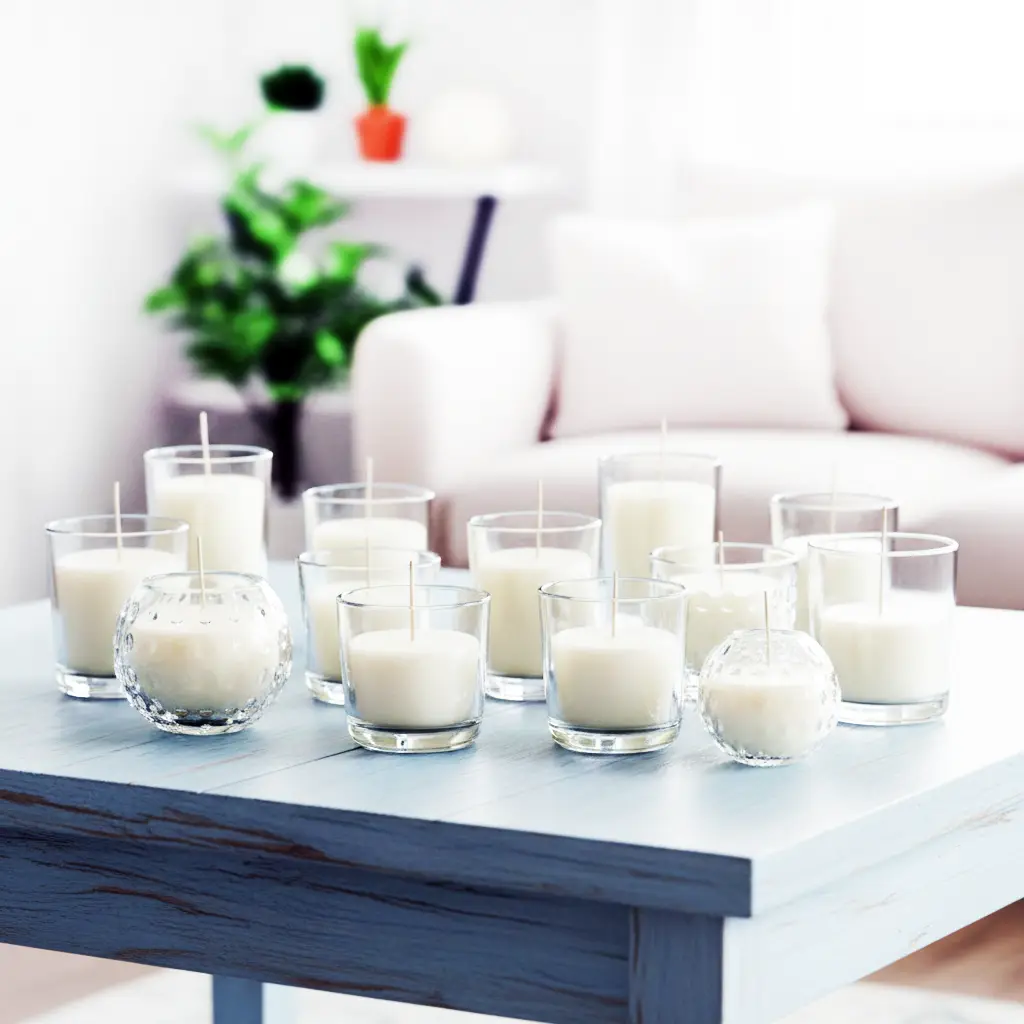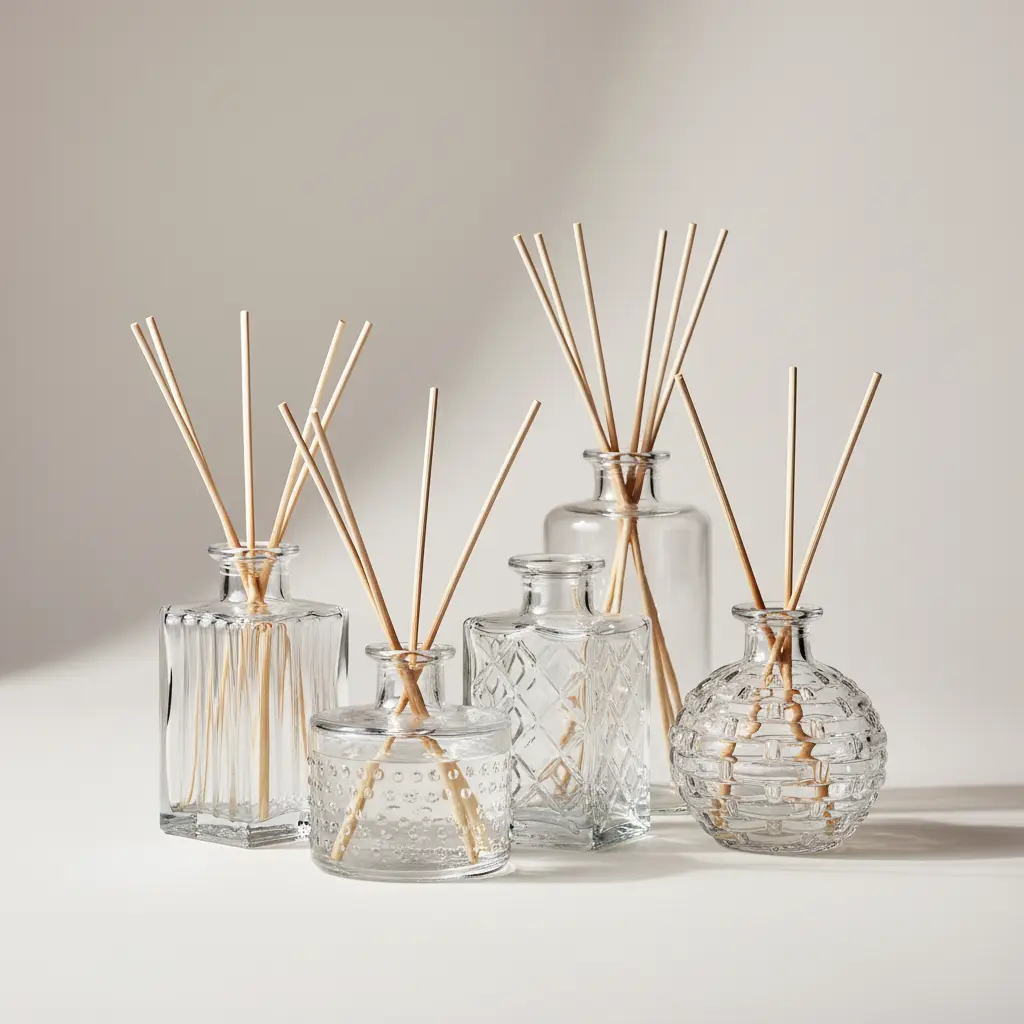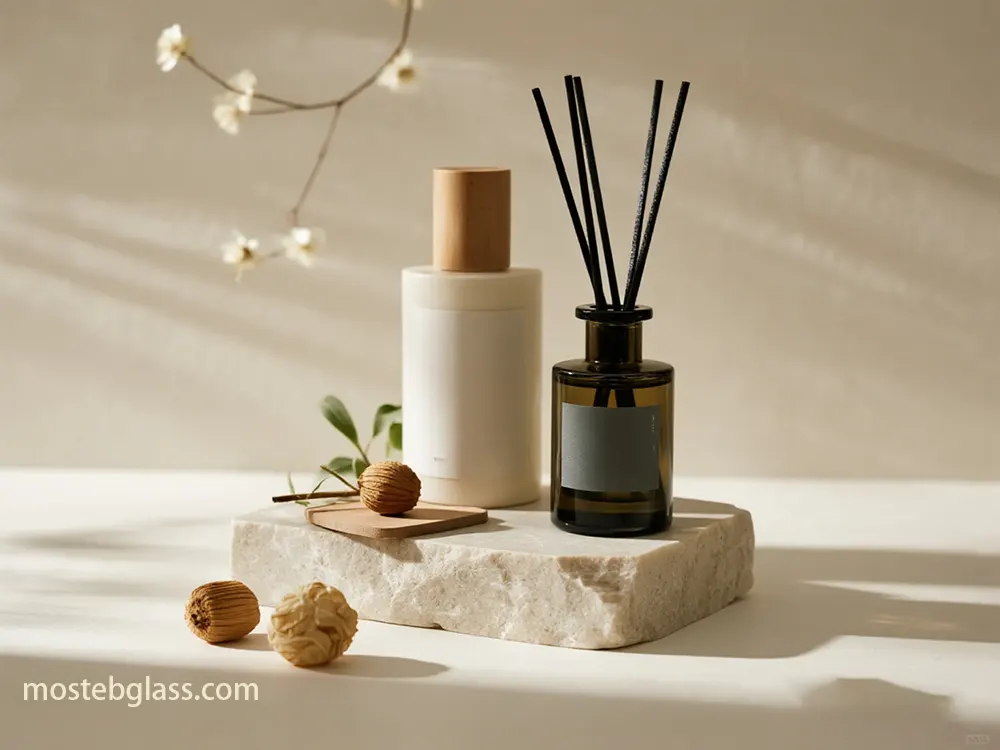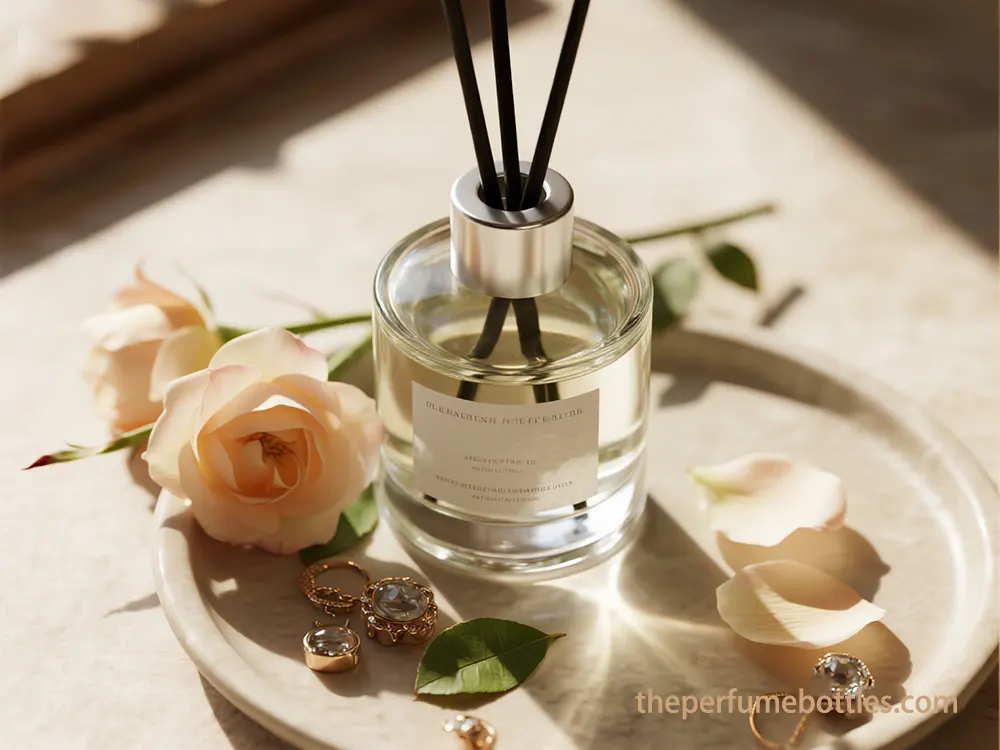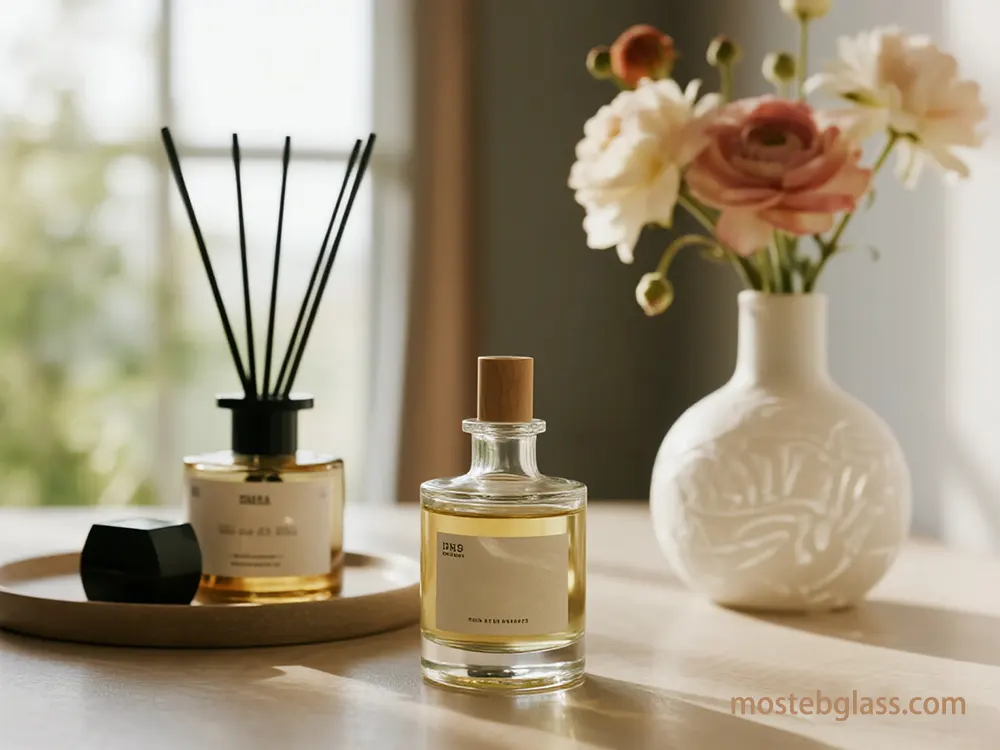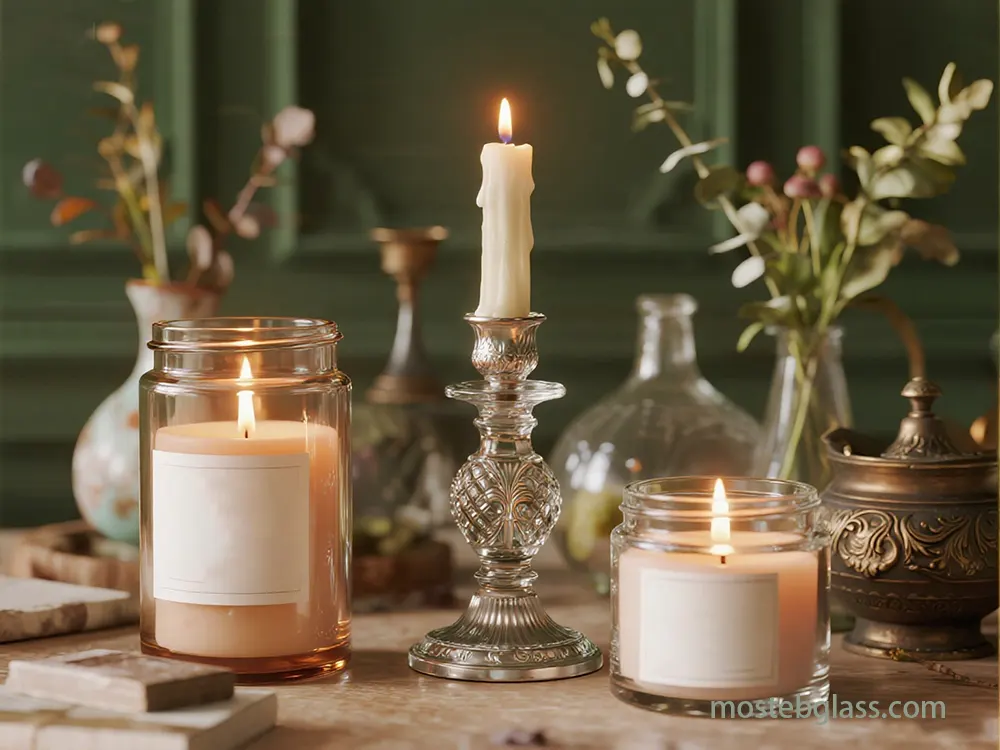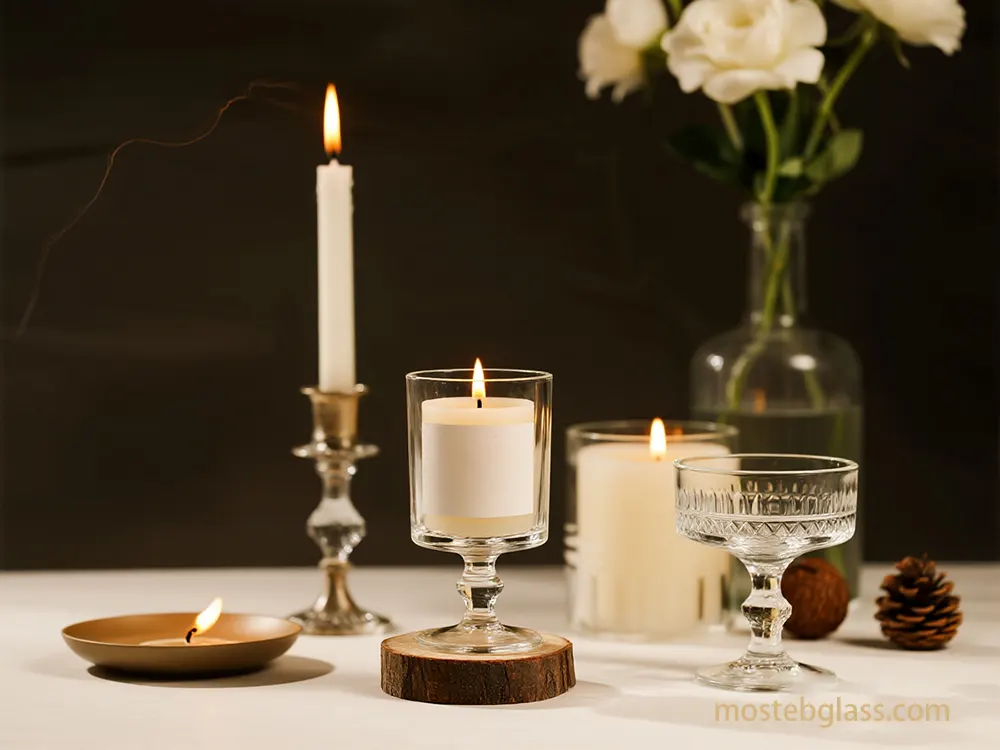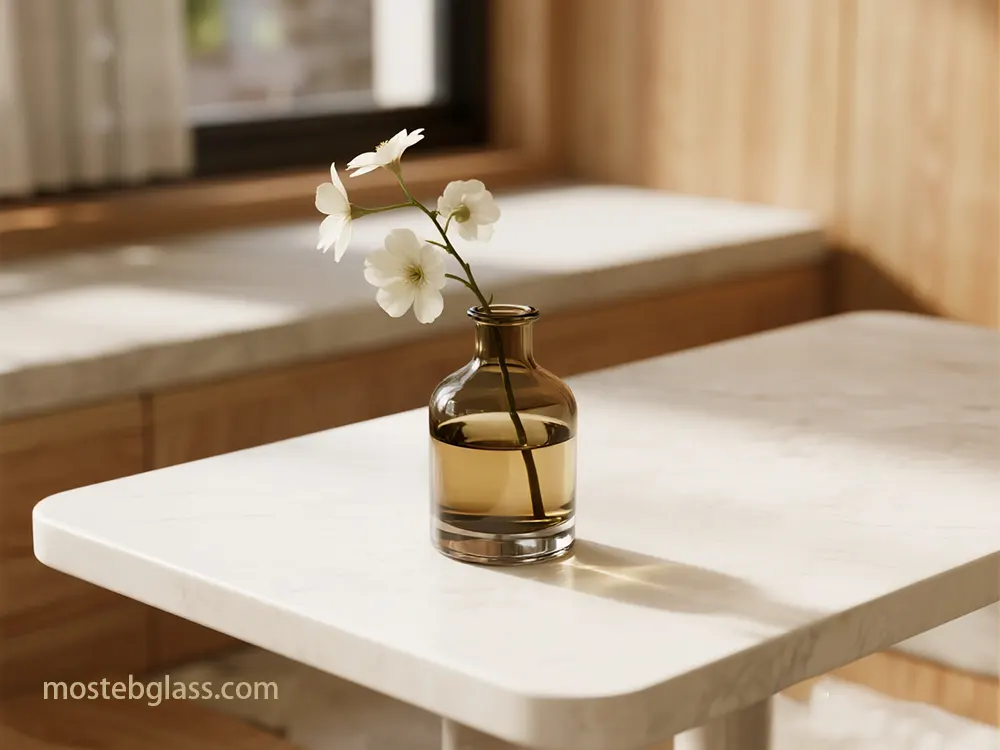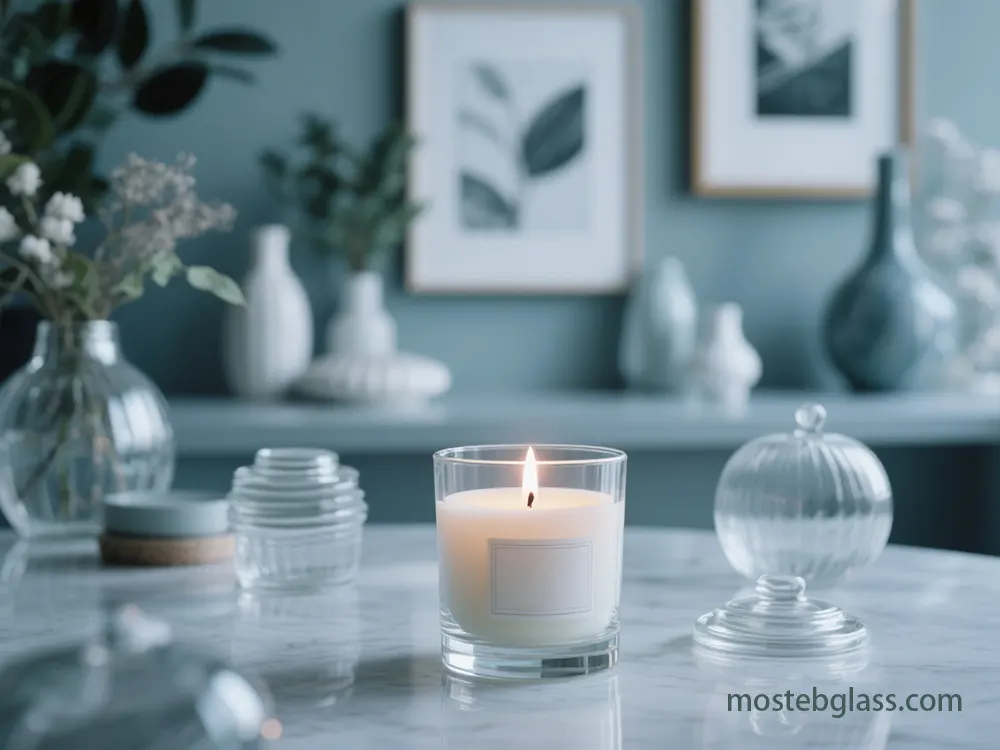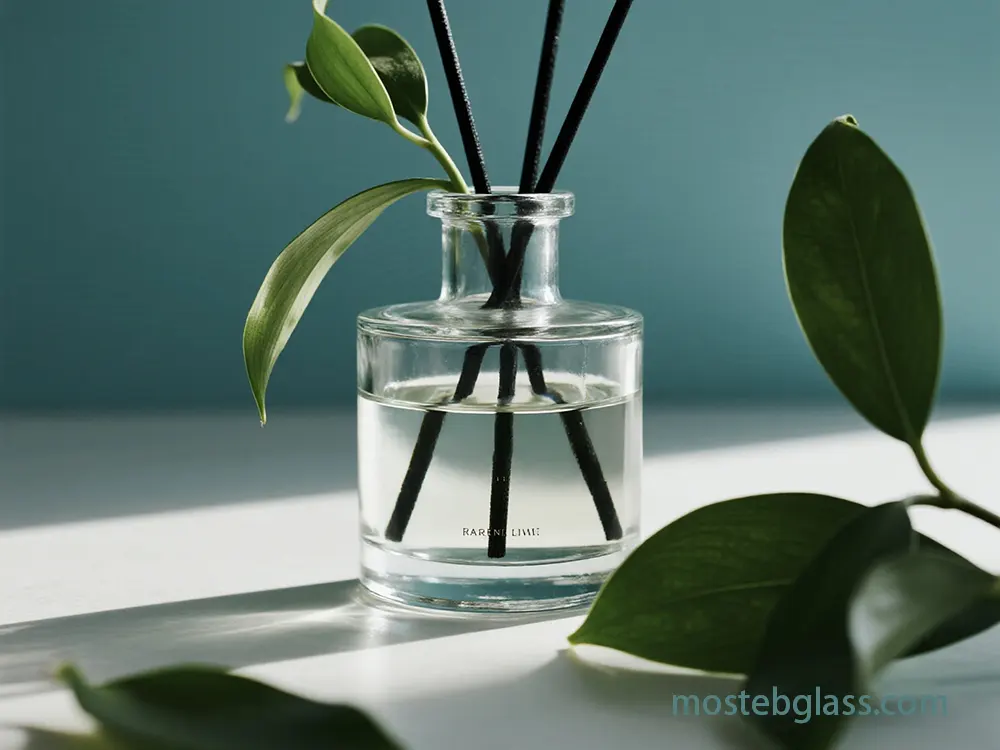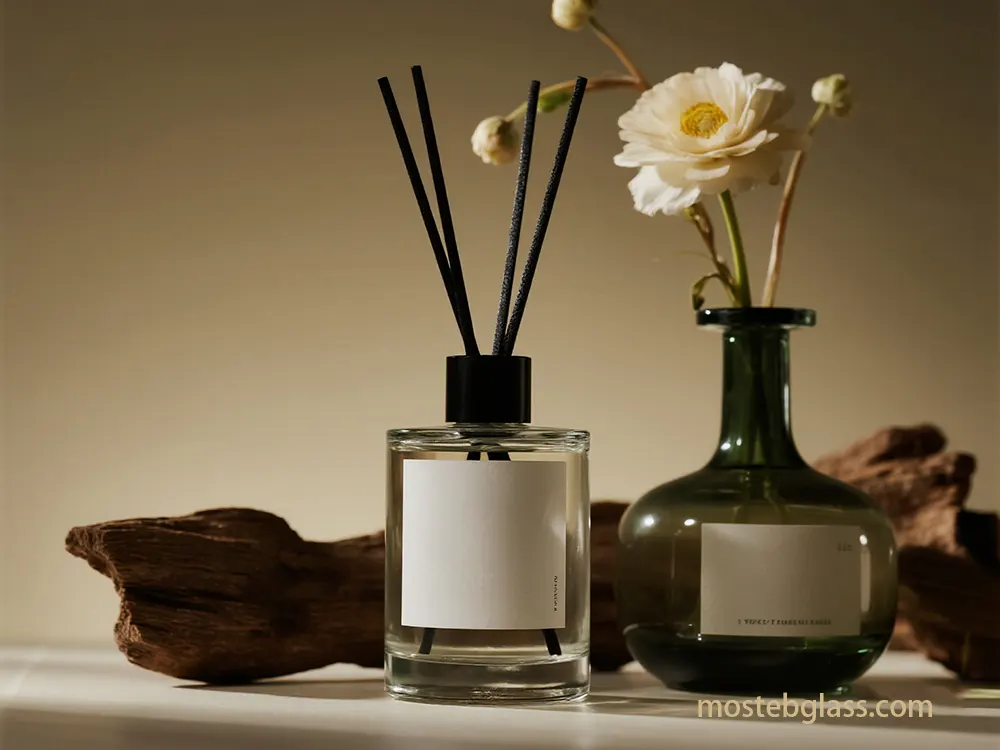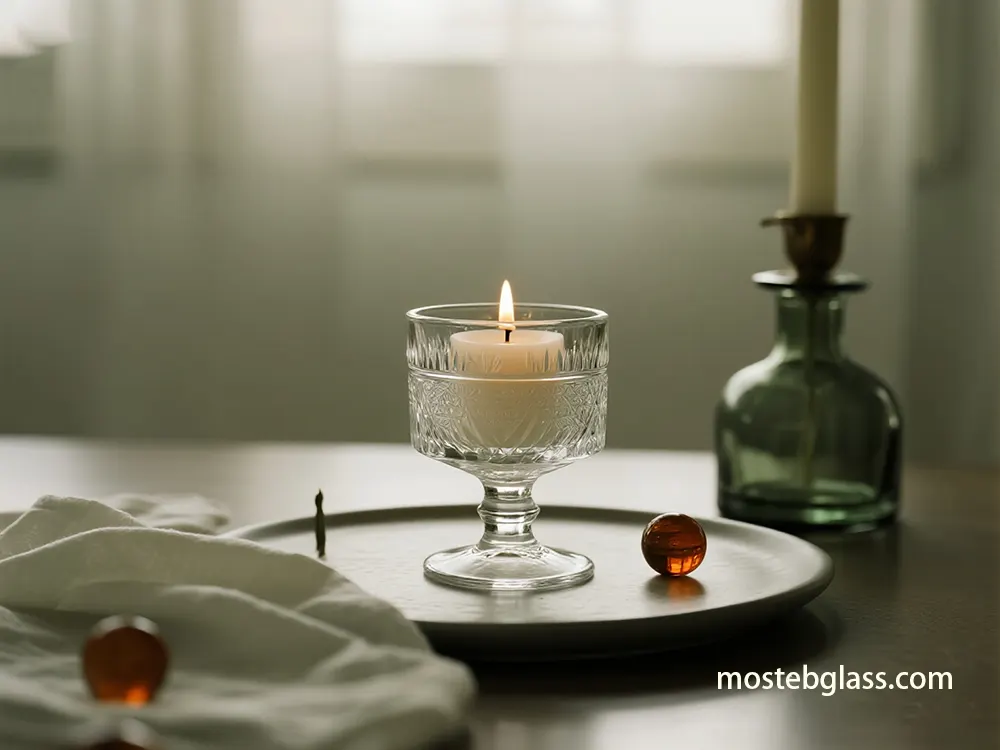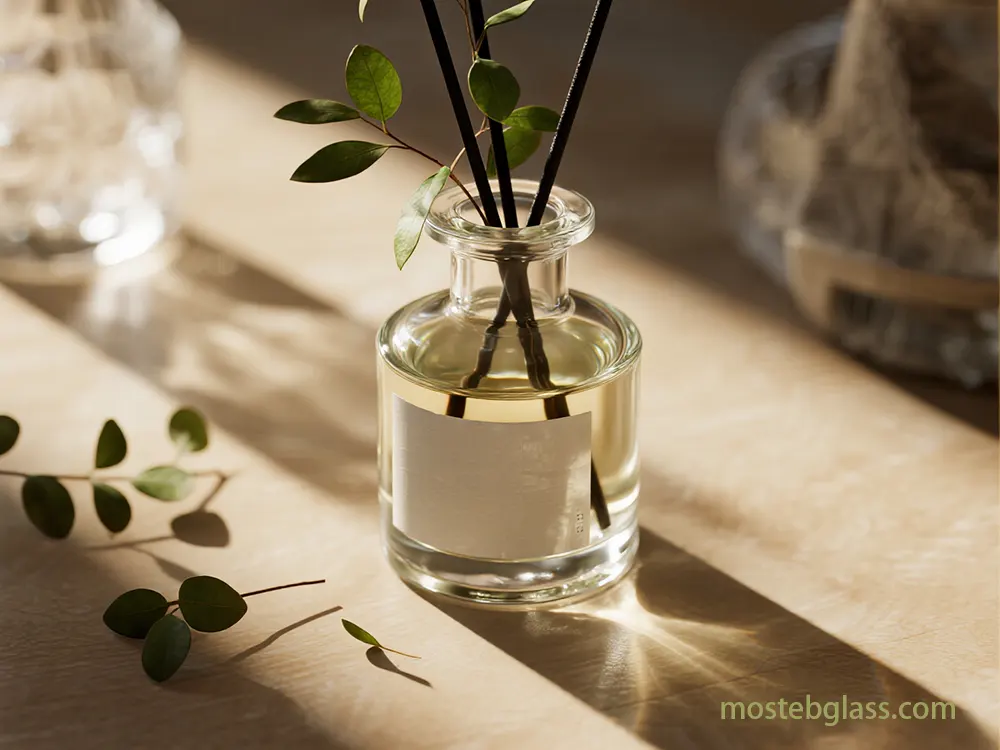Under the EU PPWR, all packaging must be recyclable by 2030 and a target of 90% collection rate of container glass has been set. North America—California in particular—has grant programs to promote the use of cullet, and the Asia-Pacific market (Vietnam, for example) is creating EPR schemes.
1. Úvod
Post-consumer bottle glass (which is formulated to set quickly) may require additional fluxing agents in a hand-blown process, thus consider carefully in artisanal settings.
2.2. Energy-Efficient Blowing and Finishing Processes
It is vital to minimize and decrease the energy footprint and consumption of glass manufacturing. Approximately 20% of global industrial use is combined by glass manufacturing.
Furnace Technologies:
Electric furnaces are 35% more energy efficient than gas-fired furnaces and have lower emissions. Hybrid furnaces have both an electric and natural gas sources, reducing energy consumption by 5-10%, and CO2 by 20-45%. Regenerative furnaces recover the heat of the exhaust stream, achieving energy efficiency of 50-65%. Oxy-fuel combustion uses pure oxygen in place of combustion air, resulting in a better energy efficiency range of 20-45% while lowering NOx emissions by 70-90%.
Heat Recovery Systems:
- Recuperative and regenerative systems preheat the air or oxygen used in combustion. Waste Heat Recovery Boiler (WHRB) produces steam from the exhaust. Preheating batch and cullet can yield energy savings in the range of 14%. Air-to-Water WHR captures thermal energy and produces a hot water source. Recuperators on studio furnaces have been shown to save 35-40% gas. Process Optimization Strategies:
- Using more cullet lowers energy consumption by approximately 3% for each 10% increase in glass batch. New controls, automation, and data analytics will optimize furnace performance. Penn State is working on a lower melting temperature glass called “LionGlass.” This has the potential to save approximately 30% energy and reduces carbon footprint nearly by 50%.Carbon Footprint Reduction Potential:
- Glass manufacturing produces at least 86 million tons of carbon-dioxide emissions annually. Electric furnaces produce zero combustion emissions (with renewable energy). Hybrid furnaces produce 20-45% less carbon-dioxide emissions; LionGlas reduces the carbon footprint by nearly half. 2.3. Sustainable Packaging Solutions for Fragile Ornaments
- Protecting fragile blown glass while minimizing environmental impact is a key challenge.Variety of Eco-Friendly Materials:
- Materials can include corrugated cardboard, biodegradable air pillows, mushroom packaging, seaweed packaging, molded pulp, and bio-based films. Design Innovations:
- Suspended box systems, foam-in-place, custom crating, with possible molded pulp trays, or honeycomb paper, create extra protection. Custom cardboard inserts hold the potential to reduce breakage by 25%, if not more. Molded pulp is made from recycled paper, but provides cushioning and can be economically viable due to reduced weight in both manufacturing and shipping. Molded pulp is biodegradable, compostable and recyclable.However, cost of the mold is high.
- Bio-based Films: Bio-based films are derived from renewable resources and reduce GHG emissions and plastic waste but often come to market with poorer properties and higher costs.
Reusable Packaging Systems:
Flexible membranes provide supportive skins to enable multiple reuse cycles, and may provide CO2 reductions of 39-82% and plastic waste reductions of 87%.
- Consumer Demand: 90% of American consumers prefer brands with eco-friendly packaging, while 43% are willing to pay more. Recycling (77%), minimal packaging (61%), and recycled materials (51%) are some of their priorities.
- Damage Reduction: Damage reduction is crucial, as damage accounts for 48% of the total environmental cost of shipping, even at 1% damage rates.
- Glass Perception: Glass is perceived as 100% recyclable and sustainable, and for this reason, in supply chain risk reduction, robust inner packaging is required to safeguard fragile materials.
- 2.4. Initial End-of-Life Considerations and Circularity Extending ornament life and ensuring responsible end-of-life is vital for a circular economy.
Logistics Issues:
Low-value, seasonal decorative goods using circular models are thwarted by a lack of expected material streams, small batch sizes, low value, and cost-effective transport methods.
- Repair/Restoration: There are specialized repair services available for art glass and decorative objects that offer guaranteed “invisible repairs” and can fabricate any missing parts, suggesting that there is already a market for product life extension.
- Upcycling: Upcycling is already a well-established end-of-life strategy for holiday decor, as many individuals take older items and revamp them into new decorations or gifts.
- Major Green Logistics Strategies: Take-back programs have trouble because consumers see unused items as “waste.” It will be critical to incentivize consumers to return unused decor and reiterate the worth of used products at the end of their life cycle.
- Advanced Recycling Technologies: Although glass is always recyclable, the inability to recycle mixed colors and slow rates of contamination can be a barrier; new technologies using AI and robotics provide optical sorting, and many scientists are examining chemical recycling. Research from Penn State (2024) suggests that mixed-color soda-lime silicate glass can safely melt together, allowing for a continuous recycling cycle that could lead to more recycling.
- Cost-Saving and Job Creation: Circular economy practices can provide cost savings and job creation.
- Design for Circularity: Products should be designed for durability, easy repair, standardization, upgradability, and disassembly from the outset.
- Partnerships and Community Development: To fully realize circularity, there is a need to bring critical supply chain partners together and partner with communities looking for solutions that include swaps and donations of ornaments for holiday decoration.
- Hand-Blown Recycled Examples: Examples exist of hand-blown glass ornaments from 100% recycled materials, demonstrating feasibility.
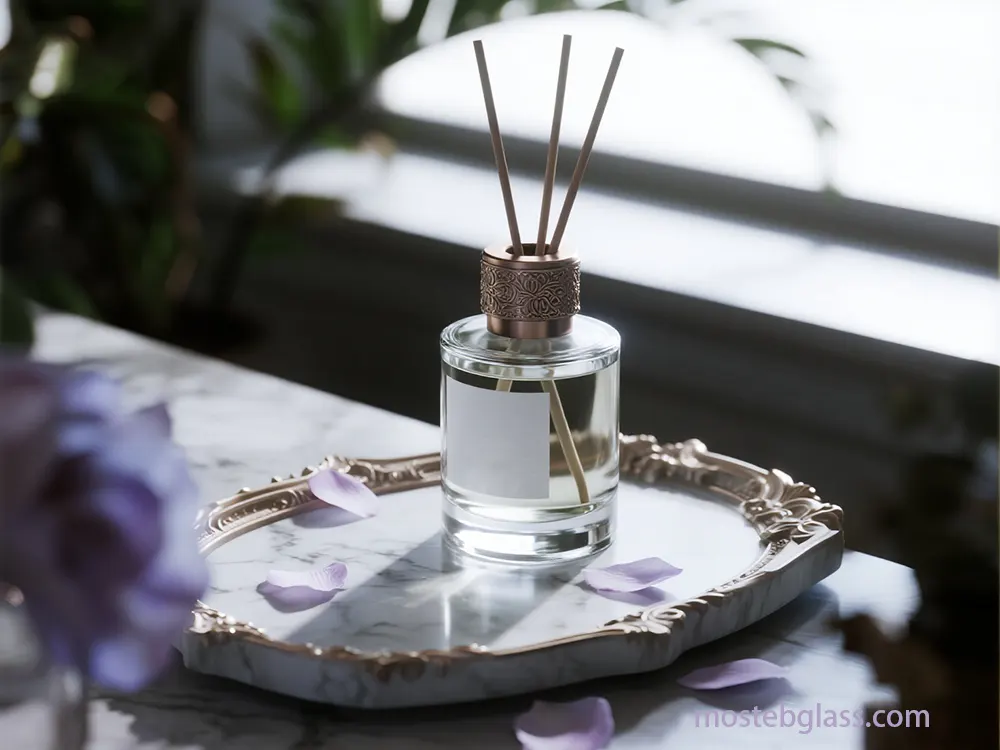
2.5. Social Equity Aspects within the Existing Supply Chain
Ethical sourcing and fair labor are increasingly non-negotiable for eco-minded consumers.
- More than 80% of shoppers consider ethical standards important. A third of shoppers will pay more for an ethical product, especially Gen Z. Ethical Sourcing Defined:
- Ethical sourcing is sourcing that considers human rights, environmental protection, community benefit, conflict-free, and fair labor. Fair Labor Practices:
- Fair labor practices should include the absence of forced/child labor, absence of discrimination, the ability to work in safe conditions, and the ability to earn a fair wage. Transparent supply chains, and lack of regulation, are obstacles. Supply Chain Transparency Issues:
- Such complex and opaque global supply chain prevents product tracing and monitoring. Best Practices:
- It is critical to publicly disclose supply chain information, conduct risk assessments, provide codes of conduct to suppliers, and monitor/ audit suppliers by credible organizations. and build long-term relationships with suppliers based on cooperation. Third Party Certifications:
- Social accountability certification (SA8000), Fair Trade, and product safety certifications (CPSIA, CE Marking, EN71, REACH, Lead-free) are all critical certifications. Industry Initiatives:
- Organizations like the Fair Labor Association (FLA) are working on protections for workers’ rights. The Responsible Jewellery Council (RJC) has developed a model to bring transparency into the industry. Retailers conduct audits of their supply chains, partner with ethical producers, and communicate their ethical practices to consumers through marketing, packaging, and education. Blockchain and certificates of origin can also assist in building trust.
- Regional Nuance: Germany is recognized for its traditional glass-making.
- Worker Empowerment: It is also very important to empower workers, not only through audits, but also through giving them reinforcement (participation and grievance mechanisms).
Technological Solutions:
PLM systems and supplier portals improve transparency by tracking sourcing and materials.
- Design for Circularity: Ethical sourcing increases brand loyalty and sales.
- 3. Emerging Technologies and Speculative Technologies The future of sustainable decorative blown glass will be influenced by advances in material science and manufacturing.
- 3.1. Advanced Glass Composition and Coatings The materials science and innovative techniques addressed here will be developing into lower melting temperature and durability of glass with new environmentally-friendly decorative features.
- New Glass Formulations: Penn State’s “LionGlass” completely replaces all carbon-containing batch materials and reduces melting temperatures by 300-400°C (1,450°C for soda-lime glass). This translates into a 30% reduction in energy consumption and nearly 50% lower CO2 emissions. It also boasts 10x improved crack-resistance and enhanced optical and chemical properties available for tuning. The industry also desires lead-free low-melting alternatives (softening before 600°C), with phosphate and bismuth oxide-based glasses as some contenders.
- Non-Toxic and Environmentally Safe Pigments: High-temperature non-toxic pearlescent pigments are a new batch of non-toxic pigments, while Nature Coatings has released 100% bio-based, carbon-negative BioBlack paint made from wood waste. Academic funding is supporting research into natural plant champions. Other options include water-based or low-VOC pigment systems. Plant oils, combined with mineral pigments, produce durable zero-VOC options with bio-based or low-impact claims in paint formulations.
- Bio-Based Protective Layers and Coatings: BioPowder.com products called “Olea Colors” replace traditional decorative flakes with refined olive stone. General bio-based coatings from renewable resources offer sustainability without sacrificing performance, quality, or durability. The global bio-based coatings marketplace is expected to expand significantly as regulations and consumer demand drive it; however, availability of raw materials and manufacturing costs will be critical challenges for producers.
- 3.2. Novel Low-Energy Blowing Techniques In addition to the material breakthroughs, there are various new manufacturing elements that indicate the possibility for glass formation at a lesser degree of energy-efficiency.
- Jar and packaging add a smooth opening, well -organized material, or an offering of special ribbons offer. A memorable unpassion encourages the purchase of repeating repeat and positive words. Unlike glass “cold work” which is a post-forming decorative step, Corning’s ColdForm™ Technology could allow ultra-thin Gorilla Glass to be formed and shaped at room temperature instead of needing energy-intensive hot molding methods. Such a change would decrease a considerable amount of energy, complexity, and cost by as much as 40% – a similar method may also apply to cold shaping decorative glass materials.
- Additive Manufacturing (3D Printing) of Glass: There is a new low-temperature additive manufacturing method which has been explored, such as with MIT’s approach to direct ink writing, which manufactures multimaterial glass at room temperature, and cures glass at a relatively low temperature of 250°C – which is a considerable reduction from the typical high sintering temperatures of >1,000°C for glass. While AM processes also make it easier to minimize material waste, traditional glass 3D printing is still energy-intensive. Glass AM also face challenges with achieving smooth surface finishes or opacity. A recent breakthrough reported in August 2024 also involved work towards a new heated method for glass DED 3D printing termed “volumetric heating” which involves and tests some initial research of the method at faster deposition rates. Lastly, while AM is a unique way to manufacture glass products, for high-performance applications, there are still strong limitations for high optical clarity and multi-material printing.
- Lastly, establishing kiln-forming as a separate method of heat treatment can also potentially demonstrate new methods of glass manufacture development and research given recent patent filings. The research community is very concerned with energy-efficient alternatives such as 3D-printed polycarbonate. 3.3. Advanced Circular Economy Models for Ornament Lifecycle
- In addition to recycling, advanced models are striving to achieve genuine closed-loop. AI and Robotics Sorting:
- The rise of AI and robotics allows for improved optical sorting for glass by color and type, and also helps to remove contamination. Chemical Recycling:
This new technology breaks glass down into different raw chemical components, which provides a solution for glass that is heavily mixed or contaminated, where it is not suitable for mechanical recycling.
Digital Product Passports and Blockchain:
With blockchain technology, these could provide end-to-end traceability for each ornament, documenting the materials used, where they were produce, energy used, and instructions for its end of life. With this immutable ledger, greenwashing could be eliminated and materials could be retained more efficiently.
Modular Design for Disassembly:
- For a speculative ornament design, one could utilize modular components that could help simplify disassembly – decorative elements could easily be removed and separated from the glass type and the hanging device. Advanced Take-Back and Refurbishment Program:
- Retailers could implement more advanced and modern take-back programs for ornaments and other similar items, creating a financial incentive for returning an old ornament for a new ornament. Once a consumer returns the ornament, it could then be assessed for repair, refurbishment, or material recovery with advanced sorting and processing technologies. This would transition the practice from simple upcycling to industrial-scale circularity. Bio-Integrated Disintegration:
- For non-glass components or coatings, research into materials that safely biodegrade or compost could offer a truly circular solution, ensuring no persistent waste. 4. Economic Viability and Premium Market Positioning
Adopting sustainable practices in blown glass ornaments involves economic considerations but does offer some opportunities in premium markets.
4.1. Cost Considerations of Sustainability in Glass Ornament Production
Recycled Glass (Cullet): Using cullet saves about 2-3% on energy consumption for every 10% of cullet used, mainly because it melts at lower temperatures. This also reduces stress on the furnace, prolongs its lifespan, and reduces the cost for raw materials and transportation. Although the glass industry has abundant recycling infrastructure, an investment in recycling infrastructure does require some upfront capital investment with ongoing operational costs that will decrease over time.
Energy Efficient Production: Transitioning to an environmentally-friendly fuel or electric furnaces may have a higher upfront cost but will ultimately lead to sustainable operational savings in the long-run. Typically, energy-efficient equipment lasts longer too, plus tax incentives can alleviate some upfront costs.
Eco-Friendly Packaging:
While initial material costs can be higher, eco-friendly packaging often leads to long-term savings from reduced waste management fees and lower shipping costs.It also enhances brand image and customer loyalty. However, glass production and recycling can be energy-intensive.
Blown Glass Production Cost Drivers:
- This category captures the studio’s operating expenses which range from $12,800 to $42,500 per month. However, the studio elements needing significant capital are rent, owner/labor salaries, utility bills, raw materials, insurance and the initial studio setup which conservatively exceeds $500,000. Saving Alternatives:
- In addition to direct energy and material conservation, a stronger brand reputation and increased customer loyalty because of sustainability efforts, could translate to more sales and reduced marketing expenses. Rebates and incentive programs from government agencies for green technology are also worthwhile alternatives. 4.2. Premium Market Positioning and Consumer Willingness to Pay
- Sustainability is a strong differentiator that allows for premium pricing for blown glass ornaments. Premium Justification:
- Premium pricing can be justified based on quality, luxury, distinctiveness, limited runs, and custom craftsmanship that highlight the artistry of the product, along with the perceived value of a handmade item. Embracing Sustainability:
- Sustainability is an evolving trend on the luxury spectrum, engaging consumers who are routinely willing to pay higher prices for sustainable and ethically-produced goods. Pricing for perceived value to consumers reflects the additional value assigned to sustainable attributes.
- Transparency and Storytelling: Transparency into sustainable initiatives, supply chains, and positive environmental and/or social impacts builds a trust with consumers that provides justification for a premium.
Consumer Willingness to Pay (WTP):
A large portion of consumers is willing to pay more for sustainable
Christmas-themed decorations:
- 41% for sustainable products in that category and 40% for environmentally-conscious products during the holidays. Other studies show 67-68% of consumer WTP for ethical/eco-friendly brands, and the average premium many consumers paid was between about 9.7% and 12%. Although, research has shown that WTP drops significantly for not exceeding 20-25% premium products.Factors Influencing WTP:
- WTP can be influenced by where the materials originated, production ethics, brand transparency, perceived quality and knowledge regarding the environment.Demographic Differences:
- Ekologické balení: Regional Differences:
- Fast growing markets (e.g., India, Brazil, China) are showing higher concern and WTP, as opposed to developed countries (e.g., U.S., Germany, UK) that show less concern but are still willing to pay a higher price. North America currently has more market share than other areas of the world but Europe pays more attention to local and hand crafted product decoration.Market Expectations and Intention-Action Gap:
- The global market share of Christmas ornaments is expected to evident grow reasonably steadily in the timeline ahead. While WTP was stated among consumers there is also the added challenge of an “intention/action gap”, particularly reliant on rising costs and consumer general difficulties identifying what were truly sustainable products. 5. Strategic Integration for Eco-Minded Retailers
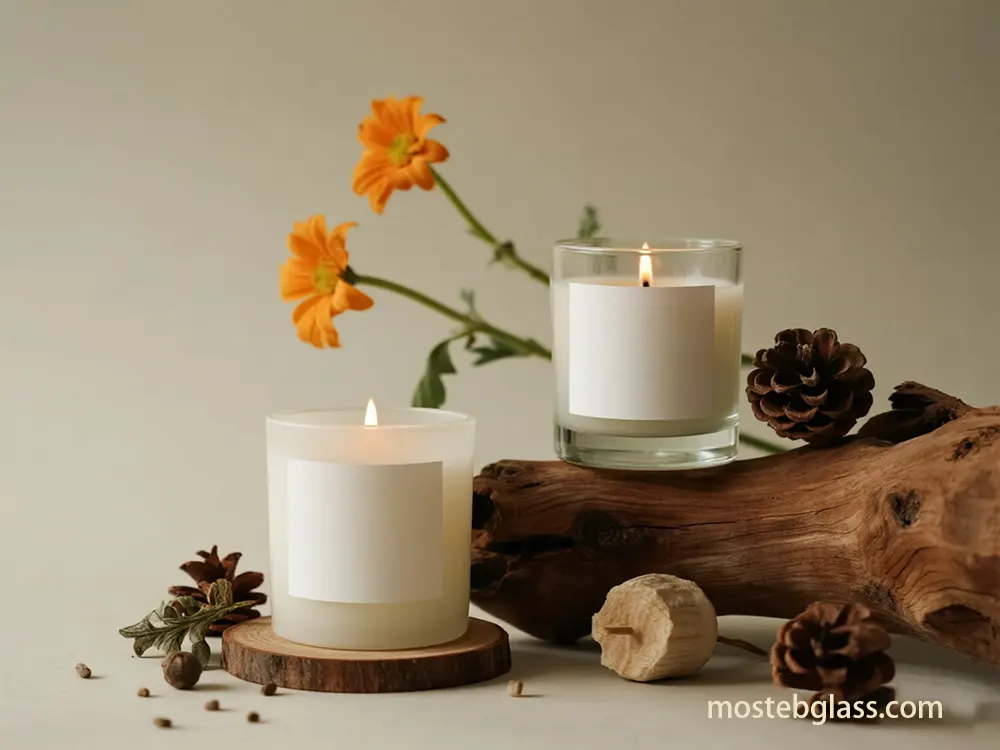
Promouvoir la fidélisation de la clientèle grâce à une initiative de stabilité interactive, des programmes de soutien technologique et des campagnes éducatives.
Alignement des politiques :
- Tirer parti des incitations gouvernementales et développer un cadre réglementaire soutenant la fabrication permanente et les pratiques d'économie circulaire. L'avenir des décorations de Noël en verre soufflé durable est prometteur, marqué par une innovation constante et une prise de conscience accrue des consommateurs. Les détaillants adhèrent à ces tendances, privilégient la transparence et intègrent des pratiques durables de manière stratégique, contribuant ainsi à un avenir plus vert et se positionnant avantageusement sur le marché florissant des décorations de fêtes.
- Large Department Stores: Position sustainable blown glass ornaments in new, dedicated “eco-friendly” sections. Collaborate with brands that are Certified Sustainable to drive broad awareness of benefits through in-store digital merchandising. Provide a range of prices to appeal to a more general shopper.
- Cenová strategie na základě hodnoty: Retailers are already in a good place to offer sustainable Christmas decorations, be explicitly clear in marketing “zero waste,” “handmade,” “recycled materials,” and “fair trade.” Quality images with descriptions and honest reporting about business impacts can ease conversion to purchase for these digital shoppers. Carbon offset shipping and access to a certification can build digital trust with eco-conscious shoppers.
- Décorations de Noël en verre soufflé durables pour les détaillants éco-responsables. Tendances actuelles Face à l'intérêt croissant des consommateurs pour les produits durables et éthiques, le marché des décorations de Noël en verre soufflé est en pleine mutation. Ce rapport Mosteb analyse les tendances et les évolutions produits liées au développement durable, ainsi que les aspects économiques, afin d'offrir aux détaillants engagés dans cette démarche des pistes concrètes. Les consommateurs sont prêts à payer plus cher pour des produits issus d'un approvisionnement responsable, d'une production écoénergétique, d'emballages durables et respectueux des droits des travailleurs. Les innovations, telles que l'utilisation de verre recyclé de pointe, de techniques de production à faible consommation d'énergie et de modèles d'économie circulaire, contribuent à façonner l'avenir du secteur. Si les coûts de démarrage sont importants, les avantages à long terme incluent une meilleure image de marque, une fidélisation accrue de la clientèle et l'accès à un marché haut de gamme en pleine expansion. Les acteurs qui intègrent le développement durable de manière stratégique et communiquent avec plus de transparence seront les plus performants.
- Le marché mondial des décorations de Noël, qui devrait atteindre 18 milliards de dollars américains d'ici 2029, connaît une forte croissance, notamment grâce aux options écologiques. La question des ornements de Noël en verre soufflé est particulièrement importante, car les méthodes de production traditionnelles ont un impact environnemental considérable. Ce rapport vise à suivre les initiatives de développement durable mises en œuvre par le secteur des ornements en verre soufflé, à destination des détaillants souhaitant intégrer de nouveaux composants écologiques à leurs marques et points de vente. Notre recherche porte sur les domaines suivants : approvisionnement en matériaux (verre vierge, post-industriel et recyclé post-consommation de manière responsable) ; consommation d’énergie (nouvelles technologies de fours, optimisation énergétique des procédés) ; emballage (développement d’options durables pour l’utilisation du verre fragile) ; fin de vie (approche d’économie circulaire par la réparation, le surcyclage et le recyclage avancé) ; et équité sociale (travail juste et équitable, transparence de la chaîne d’approvisionnement). Nos marchés cibles sont l’Amérique du Nord et l’Union européenne, avec une perspective mondiale prenant en compte les détaillants soucieux de l’environnement.
- 2. Tendances établies en matière de développement durable dans les ornements en verre soufflé La production durable d'ornements en verre soufflé nécessite une approche multifacette et globale tout au long de leur cycle de vie.
- 2.1. Approvisionnement en matériaux : privilégier les contenus recyclés et les matériaux responsables La fabrication d'ornements en verre durable repose sur le choix judicieux des matériaux utilisés. Un taux élevé de verre recyclé post-consommation peut parfois altérer la transparence du verre et du cristal, mais se prête parfaitement à la création d'ornements colorés ou irisés. Le calcin recyclé utilisé en soufflage de verre est une solution appropriée et viable, bien qu'il puisse être plus rigide que le verre vierge.
- Contenu recyclé maximal possible : Le verre est recyclable à l'infini, mais souvent, son apparence et sa fonctionnalité limitent l'utilisation de matériaux recyclés dans les applications décoratives haut de gamme. En Europe, le taux moyen de recyclage du verre d'emballage est de 52 %. Cependant, pour le verre décoratif soufflé à la main, les économies de matières premières peuvent être moins importantes que la priorité accordée à l'esthétique du produit.
- Avantages énergétiques et environnementaux : Le passage du verre vierge au verre recyclé réduit considérablement la consommation d'énergie et les émissions de gaz à effet de serre. Le calcin de verre recyclé consomme moins d'énergie avant d'atteindre son point de fusion (1 000 °C) que le verre vierge (1 500 °C), ce qui permet des gains de performance substantiels. Une augmentation de 10 % du coût d'utilisation du calcin par tonne permet aux fabricants de réduire leur consommation d'énergie dans leur four de fusion de 2,5 à 3,3 % et leurs émissions de CO₂ d'environ 5 %. Au final, l'utilisation de verre 100 % recyclé réduit les coûts énergétiques du fabricant d'environ 60 % et celle de calcin 100 % recyclé permet de réduire les émissions de CO₂ de 50 à 58 %.
- Principaux fournisseurs mondiaux et régionaux : Sibelco (qui a acquis SMI en 2024) est un leader mondial dans la fabrication de calcin propre et de mélanges, Renewi (Malte) traite plus de 1,2 million de tonnes de calcin de verre en Europe, Terraglass (Inde), SHANGHAI UNILIZ (Chine) sont également des fournisseurs de calcin nettoyé.
Défis technologiques et liés à la chaîne d'approvisionnement :
Le recyclage en flux unique produit un verre de moindre qualité (40 % recyclé) en raison de la contamination. De plus, le transport du calcin lourd engendre des coûts qui peuvent rendre le recyclage non rentable.
Certifications et normes :
- Il n'existe pas de certifications spécifiques pour le « verre décoratif », mais LEED et SCS Global Services (norme SCS-103 relative au contenu recyclé, avec un minimum de 5 % de contenu recyclé) proposent des normes connexes. Les déclarations environnementales de produit (DEP) et la certification Cradle to Cradle® sont également applicables. Environnement réglementaire :
- Conformément au règlement européen sur le recyclage des emballages (PPWR), tous les emballages doivent être recyclables d'ici 2030 et un objectif de 90 % de taux de collecte du verre d'emballage a été fixé. L'Amérique du Nord, et notamment la Californie, dispose de programmes de subventions pour promouvoir l'utilisation du calcin, tandis que la région Asie-Pacifique (avec le Vietnam, par exemple) met en place des systèmes de responsabilité élargie des producteurs (REP). Soufflé à la main contre soufflé à la machine :
- Le verre de bouteilles post-consommation (conçu pour durcir rapidement) peut nécessiter des agents de fluxage supplémentaires lors d'un processus de soufflage à la main ; il convient donc d'y réfléchir attentivement dans un contexte artisanal. 2.2. Procédés de soufflage et de finition économes en énergie
- Luxury Segment: Promuovere la fedeltà dei clienti attraverso iniziative di stabilità interattiva, programmi di supporto tecnologico e campagne educative.
Allineamento delle politiche:
- Sfruttare gli incentivi governativi e sviluppare un quadro normativo a supporto delle pratiche di produzione permanente e di economia circolare.Il futuro delle decorazioni natalizie in vetro soffiato sostenibili è luminoso, caratterizzato da innovazione continua e da una crescente consapevolezza dei consumatori. I rivenditori abbracciano queste tendenze, danno priorità alla trasparenza e integrano pratiche strategicamente sostenibili, contribuendo a un pianeta più verde e sviluppando una posizione flessibile nel mercato delle decorazioni natalizie.
- Overall, regional mobility highlights a global change towards stability with different motion and perspectives. Glass flower vase manufacturers have strategic opportunities for stability efforts for regional contexts for regional references, take advantage of local incentives, face challenges, and consumer and capitalize on developing preferences.Les systèmes de récupération et de régénération préchauffent l'air ou l'oxygène utilisé pour la combustion. La chaudière de récupération de chaleur résiduelle (CRCR) produit de la vapeur à partir des gaz d'échappement. Le préchauffage des lots et du calcin peut générer des économies d'énergie de l'ordre de 14 %. La chaudière de récupération de chaleur air-eau capte l'énergie thermique et produit de l'eau chaude. Il a été démontré que les récupérateurs installés sur les fours de studio permettent d'économiser de 35 à 40 % de gaz.
- Stratégies d'optimisation des processus :Settembre 22, 2025
- Potentiel de réduction de l'empreinte carbone :La fabrication du verre génère au moins 86 millions de tonnes d'émissions de dioxyde de carbone par an. Les fours électriques n'émettent aucune émission de combustion (grâce aux énergies renouvelables). Les fours hybrides produisent 20 à 45 % d'émissions de dioxyde de carbone en moins ; LionGlas réduit ainsi son empreinte carbone de près de moitié.
- Il mercato globale delle decorazioni natalizie, che dovrebbe raggiungere i 18 miliardi di dollari entro il 2029, sta vivendo un solido sviluppo, in particolare con opzioni ecocompatibili. Questo aspetto è importante per le decorazioni natalizie in vetro soffiato, i cui metodi di produzione consolidati sono intrinsecamente gravosi per l'ambiente. L'obiettivo di questo rapporto è monitorare alcuni dei movimenti di sostenibilità nel settore delle decorazioni in vetro soffiato, per i rivenditori interessati a sviluppare nuovi componenti ecocompatibili per i propri marchi e punti vendita.L'ambito della nostra ricerca include: Approvvigionamento dei materiali (approvvigionamento responsabile di vetro vergine, vetro riciclato post-industriale e post-consumo); Consumo energetico (nuove tecnologie di fornace, ottimizzazione dell'energia nei processi); Imballaggio (sviluppo di opzioni sostenibili per l'uso del vetro fragile); Fine vita (un approccio di economia circolare attraverso la riparazione, l'upcycling e il riciclo avanzato); ed Equità sociale (lavoro equo e trasparente, trasparenza nella catena di fornitura). I nostri mercati di riferimento sono il Nord America e l'Unione Europea, con una prospettiva globale che tenga conto dei rivenditori attenti all'ambiente.
Diversité des matériaux écologiques :
- Les matériaux peuvent inclure du carton ondulé, des coussins d'air biodégradables, des emballages à base de champignons, des emballages à base d'algues, de la pâte moulée et des films biosourcés. Innovations en matière de design :
- Les systèmes de caisses suspendues, le calage en mousse, les emballages sur mesure, éventuellement complétés par des plateaux en pâte à papier moulée ou du papier alvéolé, offrent une protection supplémentaire. Les inserts en carton sur mesure peuvent réduire la casse de 25 % voire plus. La pâte moulée est fabriquée à partir de papier recyclé. Elle offre un bon amorti et peut s'avérer économique grâce à son poids réduit lors de la fabrication et du transport. Biodégradable, compostable et recyclable, elle présente toutefois un coût élevé pour le moule.
- Il vetro può essere riciclato all'infinito, ma spesso l'aspetto e la funzionalità limitano l'uso di materiale riciclato in applicazioni decorative di qualità superiore. In Europa, il contenuto medio di materiale riciclato per il vetro da imballaggio è del 52%. Tuttavia, nelle applicazioni decorative in vetro soffiato a mano, il risparmio di materia prima potrebbe non essere così significativo rispetto alla priorità data all'estetica del prodotto. Benefici energetici e ambientali:
- Passare dal vetro vergine al vetro riciclato riduce significativamente il consumo energetico e le emissioni di gas serra. Il rottame di vetro riciclato consuma meno energia prima di raggiungere il punto di fusione, a 1000 °C, rispetto al materiale vergine a 1500 °C, momento in cui i risparmi in termini di prestazioni sono sostanziali. Un aumento del consumo energetico del 10%, in termini di costo per tonnellata del rottame di vetro, consente ai produttori di ottenere una riduzione dell'energia utilizzata nelle loro fonderie del 2,5-3,3% e una riduzione comparabile delle emissioni di CO2 di circa il 5%. Nel complesso, il vetro riciclato al 100% riduce i costi energetici per il produttore di circa il 60%, mentre il rottame di vetro al 100% ridurrebbe le emissioni di CO2 del 50-58%. Fornitori leader a livello globale e regionale:
- Sibelco (acquisita da SMI nel 2024) è leader mondiale nella produzione di rottame di vetro pulito e miscele, Renewi (Maltha) lavora oltre 1,2 milioni di tonnellate di rottame di vetro in Europa, Terraglass (India) e SHANGHAI UNILIZ (Cina) sono anch'esse fornitrici di rottame di vetro pulito. Sfide tecnologiche e della catena di fornitura:
- Il riciclo a flusso unico produce materiale vetroso di qualità inferiore (40% riciclato) a causa della contaminazione. Inoltre, il trasporto di rottami di vetro pesanti comporta costi che possono rendere il riciclo impraticabile. Certificazioni e standard:
Non esistono certificazioni specifiche per il "vetro decorativo", ma LEED e SCS Global Services (standard SCS-103 per il contenuto riciclato, minimo del 5% di contenuto riciclato) hanno standard correlati. Anche le EPD e la certificazione Cradle to Cradle® si applicano in questo caso.
- Severní Amerika: Ambiente normativo:
- In base al PPWR dell'UE, tutti gli imballaggi dovranno essere riciclabili entro il 2030 ed è stato fissato un obiettivo di raccolta del 90% del vetro per contenitori. Il Nord America, in particolare la California, dispone di programmi di sovvenzione per promuovere l'uso del rottame di vetro, e il mercato Asia-Pacifico (ad esempio il Vietnam) sta creando programmi EPR. Soffiato a mano vs. soffiato a macchina:
- Il vetro delle bottiglie post-consumo (che è formulato per solidificarsi rapidamente) potrebbe richiedere agenti fondenti aggiuntivi in un processo di soffiatura a mano, pertanto è opportuno valutarlo attentamente in contesti artigianali. Les produits décoratifs saisonniers de faible valeur utilisant des modèles circulaires sont confrontés à un manque de flux de matières premières réguliers, à des lots de petite taille, à une faible valeur et à des méthodes de transport peu rentables.

È fondamentale ridurre al minimo e diminuire l'impatto energetico e i consumi della produzione del vetro. Circa il 20% del consumo industriale globale è assorbito dalla produzione del vetro.
Tecnologie dei forni:
I forni elettrici sono più efficienti dal punto di vista energetico del 35% rispetto ai forni a gas e presentano emissioni inferiori. I forni ibridi utilizzano sia una fonte elettrica che una fonte di gas naturale, riducendo il consumo energetico del 5-10% e le emissioni di CO2 del 20-45%. I forni rigenerativi recuperano il calore del flusso di scarico, raggiungendo un'efficienza energetica del 50-65%. La combustione ossicombustibile utilizza ossigeno puro al posto dell'aria di combustione, con un conseguente miglioramento dell'efficienza energetica, che varia dal 20 al 45%, e una riduzione delle emissioni di NOx del 70-90%. Sistemi di recupero del calore:
I sistemi recuperativi e rigenerativi preriscaldano l'aria o l'ossigeno utilizzati nella combustione. La caldaia a recupero di calore di scarto (WHRB) produce vapore dai gas di scarico. Il preriscaldamento del calore di scarto e del rottame di vetro può generare un risparmio energetico nell'ordine del 14%. Il sistema WHR aria-acqua cattura l'energia termica e produce una fonte di acqua calda. È stato dimostrato che i recuperatori installati sui forni da studio consentono di risparmiare il 35-40% di gas.
- Strategie di ottimizzazione dei processi: L'utilizzo di una maggiore quantità di rottame di vetro riduce il consumo energetico di circa il 3% per ogni aumento del 10% della produzione di vetro. Nuovi controlli, automazione e analisi dei dati ottimizzeranno le prestazioni del forno. La Penn State sta lavorando a un vetro con temperatura di fusione più bassa chiamato "LionGlass". Questo ha il potenziale per risparmiare circa il 30% di energia e ridurre l'impronta di carbonio di quasi il 50%.
- Potenziale di riduzione dell'impronta di carbonio: La produzione del vetro produce almeno 86 milioni di tonnellate di emissioni di anidride carbonica all'anno. I forni elettrici producono zero emissioni di combustione (con energia rinnovabile). I forni ibridi producono dal 20 al 45% in meno di emissioni di anidride carbonica; LionGlas riduce l'impronta di carbonio di quasi la metà.
- Les pratiques de l'économie circulaire peuvent générer des économies et créer des emplois. Proteggere il fragile vetro soffiato riducendo al minimo l'impatto ambientale è una sfida fondamentale.
- Varietà di materiali ecocompatibili: I materiali possono includere cartone ondulato, cuscini d'aria biodegradabili, imballaggi per funghi, imballaggi per alghe, polpa modellata e pellicole di origine biologica.
Innovazioni nel design:
- Sistemi di scatole sospese, schiuma in loco, casse personalizzate, con possibili vassoi in polpa di cellulosa stampata o carta a nido d'ape, offrono una protezione extra. Gli inserti in cartone personalizzati possono ridurre le rotture del 25%, se non di più. La pasta modellata è realizzata con carta riciclata, ma fornisce un'imbottitura e può essere economicamente vantaggiosa grazie al peso ridotto sia in fase di produzione che di spedizione. La pasta modellata è biodegradabile, compostabile e riciclabile. Tuttavia, il costo dello stampo è elevato.
- Film di origine biologica: Le pellicole di origine biologica derivano da risorse rinnovabili e riducono le emissioni di gas serra e i rifiuti di plastica, ma spesso vengono immesse sul mercato con proprietà inferiori e costi più elevati.
- Sistemi di imballaggio riutilizzabili: Le membrane flessibili forniscono pellicole di supporto per consentire molteplici cicli di riutilizzo e possono garantire una riduzione delle emissioni di CO2 del 39-82% e una riduzione dei rifiuti di plastica dell'87%.
- L’approvisionnement éthique est un approvisionnement qui prend en compte les droits de l’homme, la protection de l’environnement, les avantages pour la communauté, l’absence de conflits et les conditions de travail équitables. Promoting customer loyalty through interactive stability initiative, tech-back-programs and educational campaigns.
- Policy Alignment: Capitalization on government incentives and developing regulatory framework supporting permanent manufacturing and circular economy practices.
The future for sustainable blown glass Christmas ornaments is bright, marked by continuous innovation and increasing consumer consciousness. Retailers embrace these trends, prioritize transparency, and integrate strategically sustainable practices, contribute to a greenery planet and developed a flexible position in the developed holiday decoration market.
